Download a PDF of Maud Cotter: linked
Transcript from MASS Magazine, 2022
Maud Cotter: linked
Maud Cotter
The summer before last I attended a funeral in County Kerry, so naturally, it rained. Afterwards, when we spilled out of the church, the rain abated and we experienced what is described as a light shower between the rain.
In what seemed like an eternity, but must have been a few seconds, the landscape of rolling hills tilted into something quite abstract floating before me. Droplets of water suspended in the air bent the great world into a dispersed vista. Thankfully these mini orbs of liquid suitably unsettled the dry reality from which I had come, and I felt overcome by an enriching happiness, a moment approaching some form of ultimate connection.
My mind craves these opportunities to spill out of its boundaries. I find it harder to work in dry weather. The mists that come in from the sea, filling headlands with every tone of grey, some soft and almost mushroom warm, help me to draw. Not to mention the rain that makes it impossible to make out what is going on outdoors. All the better for me to wash all into the forms I want to see.

the moon is falling, 2018, plastic sheeting, prestia, aeroboard, stainless steel, dimensions variable, Limerick City Gallery of Art, 2018. Courtesy the artist and domobaal. Photography by Roland Paschhoff.
Glass transcends its own materiality. That is what I like about it and that is what I expect to find in matter. It takes a bit of persuasion to prompt traditionally respected materials, such as stone or timber, to absent their positions of formal assurance, and go with the flow, in which everything becomes everything else. Delightfully unwrapped and abandoned matter knows its business, has begun this process of change. Detritus is equally undressed and ready to be reinterpreted, combined with other things. One’s efforts become mixed with an agency already begun – a rewarding partner with which to engage.
Located in my mind at a molecular level, this evolutionary movement forward shifts the appearance of form. I am reminded that the flash of being itself is something to achieve. Seems to me that this abstracted essence stands as companion to one’s efforts, an intangible presence induced by making, as though making itself is just an invitation to ‘something from somewhere else’. If we do not continue to make with our hands – we may forget this intrinsic collaborator within. When these relational values emerge in making, they become the real content, an enduring navigation into the future, if such a future exists. I suspect we are in an evolving present, a consequential embroilment of our actions in desperate need of unraveling.
Now is an apt time to ask myself if my work as an artist makes a contribution to humanity? Can I justify my use of materials, is sculpture necessary?
I do think that conceptual models of enquiry can be explored through sculpture, making with the matter at hand, seeing through it to new depths of possibility. Keeping this avenue of exploration open is necessary to maintaining resilient and adaptive minds capable of embracing and generating change, recognising new sustainable ways forward.
So I will keep going.
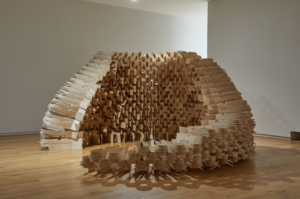
without stilling, 2017-2018, finnish birch ply, weights, 3.5 x 3.5 x 3.5 m, Dublin City Gallery The Hugh Lane, 2021. Courtesy the artist and domobaal. Photography by Denis Mortell.
Of late I have been attracted to the low glow of aluminium leaf. Illusively it is described as a silver grey. It mimics a metal and a colour. I purchased several books of leaf, and am experimenting. Aluminium leaf does not behave like gold leaf, which is skittish and flashy. Controlling air movement in the room in which one works with gold leaf is foundational. No coming or going allowed. Swift walking and waving of hands in exasperation not allowed either. A molecular stillness is necessary. However, Aluminium leaf takes it easy. I have not experienced any antics. It responds to skillful handling, and rational states of mind only.
How quiet I become when I work with it.
As a result of this flirtation, I have taken a course in tig welding, and have advanced to welding aluminium. The tungsten tip, with which one welds, does not touch the parent metals to be welded, nor does the rod of aluminium used, (something like a solder). All three elements, the parent metals, the aluminium rod and the tip, remain aloof from one another.
They take their place as though performing a minimalist piece of contemporary dance. Their relational positions and the movement of the hand weaves the weld forward, which flows of its own accord into place, performing the task in hand. This performance takes place in a canopy of gas, a dome. Feels like a watercolourist applying le petit lac to a page.
Aluminium perfectly underplays it special attributes. Being a nonferrous metal it does not rust. I have heard it is prone to a white oxidation in time, and was thrilled to hear this, though I have not yet seen such a wonder. It is alarmingly light, having spent a large proportion of my time lugging bags of plaster and sheets of timber around the studio, not to mention bunches of mild steel rod – I interpret this as a special act of kindness to the carrier. It is so easy to cut. It cuts like cake, though a bit chewy if one does not wax the blade.
This most abundant metal does not present itself in the form of actual metal but rather its compound elements are found in almost all rocks, plants and animals. Working with it is simply a form of working with oneself.
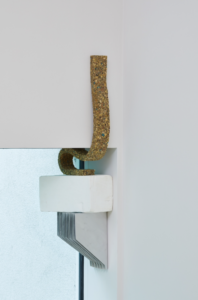
perch, 2020, aluminium, plaster, card 110 × 27 × 38 cm, Dublin City Gallery The Hugh Lane, 2021. Courtesy of the artist and domobaal. The Hugh Lane Gallery Collection, Dublin. Photography by Denis Mortell.
Flights is just that – a flighty book written by Olga Tokarczuk, the Polish author, disperse in form and full of intrigue. At its heart is a radically particular behaviour of space and time which ties events together in a way that one may easily fail to notice. Meanings remains aloof and do not gel until one penetrates its embedded spatial form. The relational network of events in the book’s narrative move forward into a deepening reality that may not be apparent on first reading, at least that was my experience.
K-A-I-R-O-S. an ancient Greek word
Operating at the conceptual heart of the book, intangible spaces and connections inspired by Kairos pull the apparently disparate elements together. The movement of a shuttle passing through a path of threads which opens before it, is a metaphor often used to describe Kairos. The projection of this shuttle is a moment of opportunity, a critical commencement and sequence of action that propels its way forward. Making sculpture feels a lot like this. The actions inherent in the making, the shifting of conceptual ground in process, and the hopeful evolution of a new physical reality. I understand the propagative potential within the object as being operative within this frame of behaviour also. I imagine that Umberto Boccioni felt like this when he made Unique Forms of Continuity in Space, the title certainly suggests so.
Actions in time and space flex forward in this new corridor which bypasses conventional strictures of time. Moments of opportune action can accelerate consequence, but that is not the only part of this concept that interests me. The radically particular moment of commencement of this process is equally intriguing. I like to think of this as a generative point. In drawing one often weaves forward from one generative point to another. Drawing in space with line, be it string or steel, one loosens out and gathers space, pulling it together – ultimately capturing a new intensity, or even a particle of void, which naturally is not captured but allows itself to be detained.
To show that intangible values are the relational glue that holds things together is worth doing, and making it happen with the very stuff of matter is worth a life’s effort. Opening new space is a real ambition in making, a contribution of conceptual heavy lifting on the part of sculpture. Space held open to allow something else to happen, something not yet imagined. A space of readiness to change.
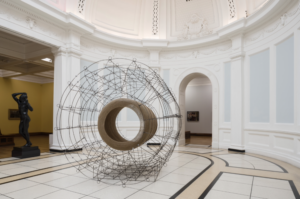
matter of fact, 2016, mild steel, card, primer 240 × 240 × 300 cm, Dublin City Gallery The Hugh Lane. Courtesy of the artist and domobaal. The Hugh Lane Gallery Collection, Dublin. Photography by Roland Paschhoff.
Download a PDF of a body of work
Transcript from a consequence of, 2021
a body of work
Maud Cotter
There is no absolute measure applied to the making of a body of work. Such an undertaking starts as a raggy form of gather and ends with its arms wide open to future possibility. But in the stream of such a flow are points of arrival and departure, a consistency of focus and deviations. I hold all these as necessary, and I have learnt to cherish and respect the deviations, those ramblings of the mind, away from the matter at hand. Sometimes those tributaries glimmer for a time and dissipate, and sometimes in a flash, they show a glimmer of something real.
To gather the work in a generous and unrestricted way was important. I needed a title or word to act as canopy, a shelter under which the bits and pieces could be stored, one that was capable of being in the public realm while the other companion titles remained private.
The word consequence survived my thinking about it. I liked the pre-existent condition within the word, an established something that sat there waiting for the inevitability of a rogue action which induced consequence. Typically, consequence is understood as something inconvenient, opening a feeling of dislocation, an awkwardness that comes with change. This hybrid space suited me. I lifted the word up to a lighter feeling with an indefinite article ‘a’, and finally, I added ‘of’, which seemed to me like adding a piece of air, for no reason.
This title has turned and twisted its way forward with the work which now sits in an accelerated space of consequence – an enactment of will within the indifferent agencies shifting the minutiae of consequence in all our lives. I seek to comprehend the world I see in my head, bring that very private space into physical existence.
The world as I see it is multi-dimensional, hard to grasp.
Description is a tricky business, it may destroy the work, so I will try to avoid that. However, I will say, every time I am drawn into an over-resolved solution to a work, I withdraw, knowing that I have lost something important to the task in hand. I return to a simpler condition, an earlier place along my path. I draw out territories that are being left behind, solutions that are not perfect enough to be counted as esteemed values of commodity.
In this flotsam jetsam, inside out world, cut through with different timescales and variant forms, I exist and think.
I like to keep away from the over finish of material, the vividness of consumerist culture. I do not want to be super-efficient or seek perfection. I like to work slowly, to find an invisible entity and nurture it into being something else. Having done that I can make a piece and let it be, relaxed, unmade, just found…… just itself.
I find that contrary behaviours suit my purpose.
My companion ghosts line up as vague and elusive creatures: the live evolution of form, the falling away and emergence of new coherences, the nature of our coexistence within matter, the indifferent agencies within which we act, the wit of human interaction within all of this. I lift the work away from being too grounded physically; it seeks lightness and conceptual rootedness at the same time. The manner of its attempted escape from gravity, the fineness of connection with which it is tethered, speaks to an intrigue between mind and matter.
Bringing the location of the work into my field of vision was important in each venue, to express it through the physical and spatial character of each place. The opportunity of developing these relationships has allowed the work to flourish. I accept these spaces as gifts.
a consequence of – without stilling
The first exhibition in the trio of exhibitions was held at Limerick City Gallery of Art in 2018. I responded to the topography of the ground floor galleries as a landscape on which I could set the work in play. I can still see without stilling as it sat un-enhanced by artificial light, darkening as the evening crept into the gallery, the insistence of its many parts acting together. It enfolded and released itself. It stood in its own presence as an attribute of physical reality – in my recollection, the other works gather round.
a consequence of – a breather of air,
In my second exhibition at The Dock, Carrick on Shannon, the sensation was one of breathing. Historically a place of detention and judgement, its flinty limestone exterior skin tenderised my responses to the interior, naming it as lung. I worked to activate a respiratory engagement of one room to the next – a breather of air brought human consciousness to play in the persuasion of matter to a new intensity. Part of the respiratory solution of the space was to let it be itself, open to its own proportions and relationships. I then allowed the works to intensify that condition.
a consequence of – a dappled world, my third and final exhibition will be held at Dublin City Gallery The Hugh Lane. The exhibition is conceptually centred in the lightly assembled seam that is the hall and stairway which serves the galleries on either side.
This seam provides me with an almost geological construct to work with, not unlike that found in the rift valley Pingvellir in Iceland which marks the crest of the Mid-Atlantic ridge. Formally the island of Iceland is ingesting itself, continually being corroded at its edges and opening along this unfathomably deep fault line running through the centre of the island. This geological continuum serves me well. A seam of ideas will be located here in the hall. Their opportunism and hybridity will aerate the work, dividing the plateaus of the exhibition on either side.
a dappled world, the third showing of the emergent work in flow, holds both the exteriority of the physical world, and the ‘inscape’ of Gerard Manley Hopkin’s invention, in unison. In this generative field, the work exists. I hope that its interwoven concerns reach coherence in this consequential field of endeavour. I await the installation.
Download a PDF of Artists’ Takeover: Maud Cotter
Transcript from Hugh Lane Gallery, 2021
Artists’ Takeover with Hugh Lane Gallery
Maud Cotter
‘In poetry all things seem to touch so they are’ *1
The relational space that Susan Howe opens in her poetry suggests that everything that we touch brings us into being with it. Coming into our minds in relational form as experience, it’s pulses enfold with our own. What I touch with my mind will make me who I am.
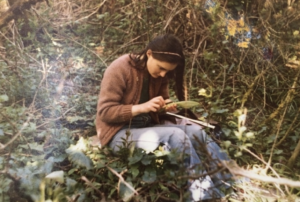
looking at a leaf in 1972. Photograph by Jennifer O’ Sullivan
She speaks of her debt to Wallace Stevens “for ways in which, through words frequencies and zero zones, his writing locates, rescues, and delivers what is various and vagrant in the near at hand”. *2
From the ground-up is how I like to begin, with a simple fold or slit in something nearby; a bottom up way of making. Working with what is to hand can unwrap other mutations in material behavior, waiting until things tire of busy-ness and simply present their skeletal selves.
Folding and welding plastic for the moon is falling created a semblance of wellbeing, a florid and repeating order woven with an asphyxiating and ruinous material. The thicker gauge blue plastic I used, pulls the other thinner transparent plastic into line, a semblance of life. This dead field which mimics life is a core ingredient of this dystopian work, “an inevitable knowledge, Required, as a necessity requires”. *3
Apparently, the moon gives an impression of falling as it orbits the earth elliptically, sometimes it is large and close by, other times it appears to fall away.
______________________________________________
After the leaves have fallen, we return
To a plain sense of things. It is as if
We had come to an end of the imagination,
Inanimate in an inert savoir.
It is difficult even to choose the adjective
For tis blank cold, this sadness without cause.
The great structure has become a minor house.
No turban walks across the lessened floors.
The greenhouse never so badly needed paint.
The chimney is fifty years old and slants to one side.
A fantastic effort has failed, a repetition
In a repetitiousness of men and flies.
Yet the absence of the imagination had
Itself to be imagined. The great pond,
The plain sense of it, without reflections, leaves,
Mud, water like dirty glass, expressing silence
Of a sort, silence of a rat come out to see,
The great pond and its waste of the lilies, all this
Had to be imagined as an inevitable knowledge,
Required, as a necessity requires.
Wallace Stevens, ‘The Plain Sense of Things’ *3
______________________________________________
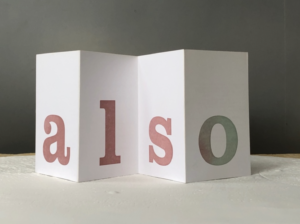
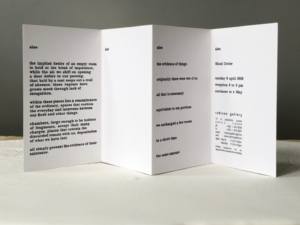
invitation for ‘also’ exhibition, Rubicon Gallery, by Coracle Press, 2002
The word also provides a place within which things can sit together. It is possible to step about in the word, enjoy its spaces, count its letters as individual entities.
I was gathered by the word into a place to work.
Coracle Press designed an invitation for an exhibition of mine of the same title, also, Rubicon Gallery, 2002. The invitation presented as a concertina of lowercase letters folded together to form the word. Half sentences and bits from my sketch books were added as a list, not a poem, to the inner folds.
the implied desire of an empty room is held at the brink of impatience, while the air we shift on opening a door defers our passing. that held by a coat seeps out a trail of absence. these vapors have grown meek through lack of recognition. within these pieces lie a remembrance of the ordinary, spaces that cushion the everyday and intervene between our flesh and other things. chambers, large enough to be holders of fragments, accept their many charges. places that contain the discarded remain with us, depositories of what we have lost.
all simply present the evidence of their existence *4
______________________________________________
Work flows from making and watching for points of entry, for ways of harnessing the energy and volition within matter.
A merged practice of looking, thinking, and making, works for me. These strands need time to integrate, time to gain strength of purpose.
Finding a way forward, is an ongoing challenge, a place where propagative ideas and making become the engine of sustainability.
The nature and meaning of physical reality is important to me. Our immersion within matter is a fit subject for a sculptor such as myself.
The field of play is much more varied than it might initially appear.
‘All things counter, original, spare, strange;
Whatever is fickle, freckled (who knows how?)’
Gerard Manley Hopkins, ‘Pied Beauty’ *5
_____
“(Who knows how?)”
In this short piece, I would like to:
air questions within my practice, on the nature and how of things
find new coherences in a field of change
speak to the continuity of practice, of finding generative ways forward
& answer some questions … if possible
This I will illustrate with some of my work to date, and work in hand, focusing on the question, posed by Gerald Manley Hopkins in ‘Pied Beauty’,“(Who knows how?)”, his exquisite uncertainty a better foundation than most.
Maud Cotter,
July 2020
a 30 minute lecture given as part of the national sculpture factory’s loquium series, 2020
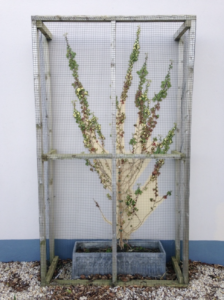
#strangehusbandry, Kerry, 2017
The Dappled World: A Study of the Boundaries of Science by Nancy Cartwright holds an eclectic, rigorous, and playful description of physical reality.
“The laws that describe this world are a patchwork, not a pyramid. They do not take after the simple, elegant and abstract structure of a system of axioms and theorems. Rather they look like – and steadfastly stick to looking like – science as we know it: apportioned into disciplines, apparently arbitrarily grown up; governing different sets of properties at different levels of abstraction; pockets of great precision; large parcels of qualitative maxims resisting precise formulation; erratic overlaps; here and there, once in a while, corners that line up, but mostly ragged edges; and always the cover of law just loosely attached to the jumbled world of material things”. *6
______________________________________________
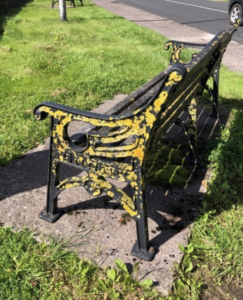
park bench, Cork, 2021
I remember those early days of the first lockdown walking in an empty city and being enthralled by a feather spinning in the wind, caught in a spider’s web, and the huge built world in stillness, the end of a certain kind of time and the beginning of another.
In this new time a park bench has embroidered itself for the oncoming revelry.
Knobs of moss have swollen, upholstering snug spaces.
Crows cross the street like citizens of a new wonderland.
All the consequence of a changing reality.
______________________________________________
The acceleration of consequence is pervasive, as we manufacture unnecessary commodities.
This tensions the place of making. I change to a different pace of assimilation, I slow down, dig deeper.
The body is stretched paper thin.
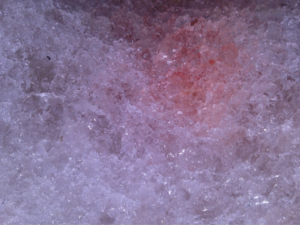
fish blood on ice, English Market, Cork. 2018
______________________________________________
constriction invites expansion.
I am making a bookmark, a bolt of lightning, a zig zag expansion of two sentences by Susan Howe, the American poet.
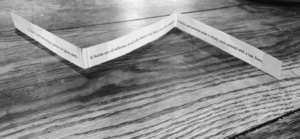
bookmark sketch by maud cotter, 2021 *7
‘If a line is quick and strong it pierces our glassy earth. It bursts out of reflection on all sides because the heart refuses to be imprisoned; in its first and narrowest pulses it already tends outward with a vast force.’ *8
______________________________________________
In 2020, I worked collaboratively with Simon Cutts of Coracle Press on my hot water bottles work titled unique forms of continuity in space, eleven.
Coracle made a book – casebound with picnic-paper over boards with an embossed cover image. Inside there are seven tipped-in images of the works from the sequence to accompany poems by Simon Cutts. 36pp, 17.5 x 15 cm *9
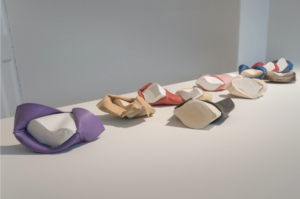
unique forms of continuity in space / eleven
maud cotter, The Dock, 2018-2019, rubber, prestia plaster, 12.5 x 23 x 15 cm
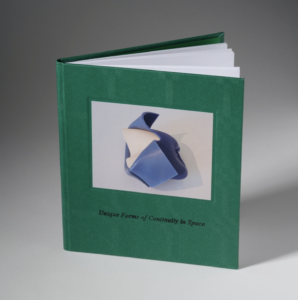
maud cotter and simon cutts, unique forms of continuity in space, book, coracle, 2020
______
A reading of five poems from ‘unique forms of continuity in space’, by Simon Cutts, 2021
______________________________________________
*1 quote: susan howe from her book of essays ’the quarry’, chapter five ‘arisbe’, published by ’new directions’ or nd books in 2015, ISBN 9780811222464
*2 quote: susan howe from her book of essays ’the quarry’, chapter one ‘vagrancy in the park’, section one ’roaming’ published by ’new directions’ or nd books in 2015, ISBN 9780811222464
*3 quote: https://www.poetryfoundation.org/poems/49420/the-plain-sense-of-things
*4 notes from sketchbooks: maud cotter, 2002
*5 quote: https://www.poetryfoundation.org/poems/44399/pied-beauty
*6 quote: nancy cartwright from her book, the dappled world: a study of the boundaries of science, introduction, published by cambridge university press in 1999, ISBN 0 521 64411 9
*7 the bookmark forms part of the forthcoming publication by dublin city gallery the hugh lane, a consequence of – a dappled world, designed by tony waddingham, 2021
*8 quote: susan howe from her book of essays ’the quarry’, chapter one ‘vagrancy in the park’, section two ’ring around the roses’ published by ’new directions’ or nd books in 2015, ISBN 9780811222464
*9 http://coracle.ie/unique-forms-of-continuity-in-space/
courtesy of maud cotter and domobaal